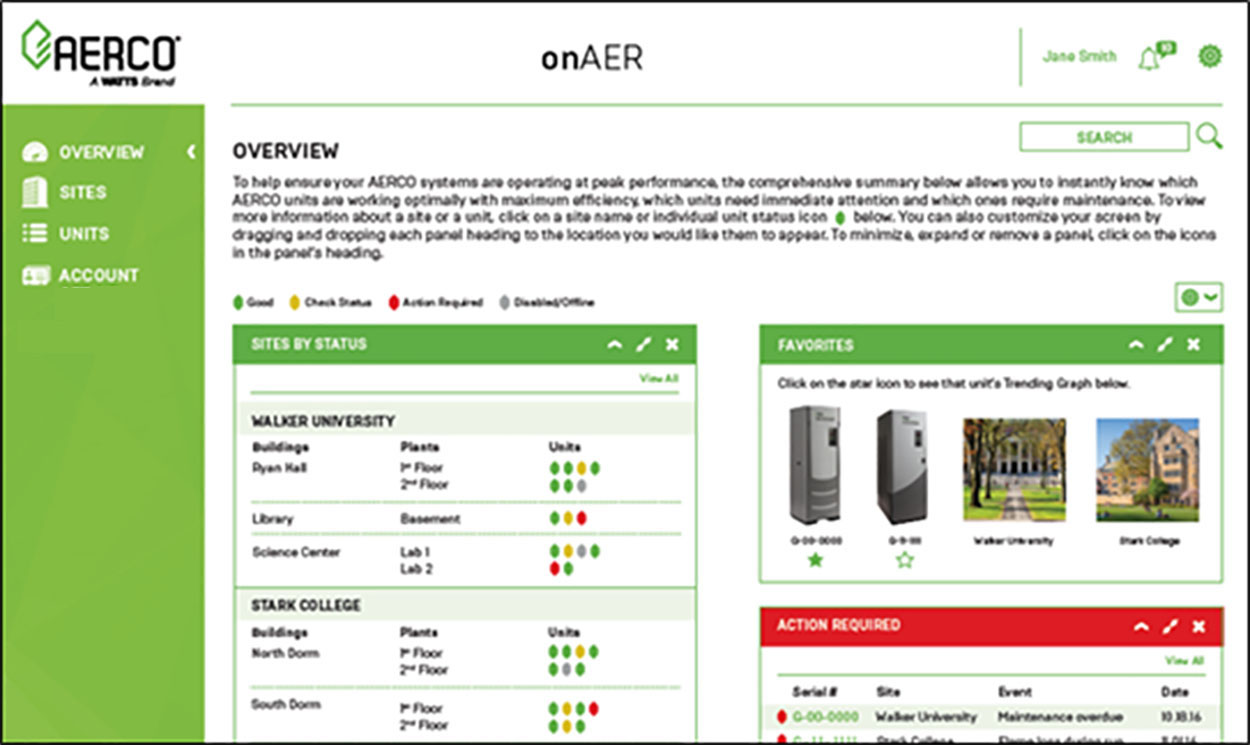Many multi-building campuses have traditionally used centralized systems to provide heat and hot water to all facilities. As boiler technology advances, however, consideration should be given to utilizing decentralized systems for new projects and retrofits alike. The key is to select the proper equipment to maximize the design and realize the greatest return on investment.
Converting to a decentralized system will likely have greater upfront costs compared to updating an existing centralized plant. Typically, these additional expenses are associated with planning, construction, installation and setup of multiple boiler rooms. Utilizing the proper equipment, however, will reduce ongoing operating expenses, creating lower cost of ownership over the life of the system.
Comparing Centralized And Decentralized Systems
Centralized heating plants deliver heat for an entire network of buildings. A massive load and very large footprint are required with this design. Typically, the centralized heating plant is connected to those buildings via an underground piping network. For this reason, the boiler system must compensate for a temperature drop that occurs as the hot water travels to each facility. Because temperatures at the point of use are normally lower, heat exchangers are necessary to deliver the desired temperature to the terminal units.
Conversely, each building has its own boiler room in a decentralized heating system. Among the many benefits of the design is that it allows for proper sizing of the boiler plant to match the heating requirements of the designated building. The inherent inefficiencies associated with an oversized, centralized system are eliminated. Additionally, there are no heat losses associated with hot water having to travel through a vast underground distribution piping system.
Importance Of Boiler Selection
Selecting the proper boiler is imperative when designing a decentralized system. Commercial boilers (Figure 1) with an ultra-compact design that have a smaller footprint and fit through a standard doorway effectively address space concerns. They also significantly reduce time, cost, and labor during the installation process.
Integrating the proper boiler also lowers the lifetime cost of ownership in three main ways:
• Eliminates Underground Piping: Pipes crack and leak over time, which may exacerbate heat losses and decrease system efficiency, resulting in higher energy, water, and sewer costs. Building owners must also factor in the inevitable expenses and practical implications of repairs and replacements of an aging network of underground pipes.
• More Efficient Operation: Smaller, multiple heating plants are more energy efficient. In addition to a positive impact on the building’s carbon footprint, the result is quite significant energy cost savings that typically quickly offset the higher initial costs.
Part of the greater ROI is that a decentralized system enables facility managers to implement an operating expense management control program. Meters are installed in all buildings, so heating, electrical and water usage can be monitored. Each system can be optimized to operate at maximum efficiency, unlike a centralized system that utilizes single meters for the entire facility-wide load.
Another key reason for greater energy efficiency is that centralized systems with larger boilers have only one power level – 100%. When it is not fully firing, the heat exchanger cools, and it must be completely reheated before heat transfer begins. Cycling losses occur every time the unit is shut down. Compounding the inefficiencies is that centralized systems are prone to poor performance during partial load conditions, which is more than 80% of the year, as well as during off hours.

Decentralized systems utilizing modulating heating plants greatly improve efficiency in the warmer months, when the loads are small, because they don’t operate at full fire. Constant operation maintains temperatures within the heat exchanger, yet the reduced input increases the time combustion gases are in contact with the heat exchanger surface.
The result is greater energy transfer and cooler exhaust gases. Fully modulating boilers create an inverse efficiency curve, as they perform best at the lowest load levels (Figure 2).
• Repairs & Maintenance: Because centralized systems operate at higher temperatures, the heat exchanger and other boiler elements typically are replaced more frequently. Diminishing system efficiency, declining reliability and a decreased lifespan are common repercussions.
The magnitude of repairs and maintenance associated with centralized systems also tend to be much greater due to the larger scale of components involved. This will manifest itself in various ways, such as longer service time, more staff to service the plant and longer wait times to source components.
Every building is affected when a centralized system is shut down for maintenance or repairs. With a decentralized system, each building produces its own heat and hot water. When repairs or maintenance are necessary, the modular design allows the other boilers in the building to operate to create a level of redundancy.
Technological Benefits
Selecting boilers with advanced remote monitoring (Figure 3) is another means to lower operating costs with a decentralized system. Monitoring tools greatly reduce the need for and frequency of physical presence and manual intervention in each mechanical room.
Certain boiler controllers give detailed real-time system performance, so facility managers can better perform predictive maintenance to avoid costly repairs and preventable downtime. Some solutions provide possible causes and suggested actions, so the repair crew can arrive with the proper information, components, and maintenance tools. They can also deliver instant alerts via email or an app to notify facility managers if a unit is down or a boiler needs immediate attention.
Additionally, advanced controllers also have economic and timesaving benefits, as they can reduce installation and start-up costs. Plus, system start-up and maintenance time can be reduced by 50%, even for complex systems
Environmental Benefits
Financial impact is not the be-all and end-all of the analysis. Decentralized systems are also more environmentally friendly. Eliminating underground piping distribution systems removes the possibility of hydronic water leaks, which can have a severe environmental impact. Carbon emissions are typically lower with a decentralized system, as well. Moreover, smaller, modern boiler designs feature low NOx burners to help improve air quality.
In conclusion, decentralizing heating systems can lead to multiple benefits, ranging from lower costs to a smaller carbon footprint. The key is to select the proper equipment, particularly boilers. Installing modulating boilers with advanced controls and remote monitoring for a more effective plant management and maintenance program will help reap maximum ROI.
Christian Zapata is a product solutions manager for AERCO International, a WATTS brand company. He joined AERCO in 2000 after earning a BS in Mechanical Engineering at the New Jersey Institute of Technology.




